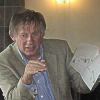Christopher Alexander

Christopher Alexander
Christopher Wolfgang Alexander is a widely influential architect and design theorist, and currently emeritus professor at the University of California, Berkeley. His theories about the nature of human-centered design have had notable impacts across many fields beyond architecture, including urban design, software, sociology and other fields. Alexander has also designed and personally built over 100 buildings, both as an architect and a general contractor...
NationalityAmerican
ProfessionArchitect
Date of Birth4 October 1936
CountryUnited States of America
There is one timeless way of building. It is a thousand years old, and the same today as it has ever been. The great traditional buildings of the past, the villages and tents and temples in which man feels at home, have always been made by people who were very close to the center of this way.
We are searching for some kind of harmony between two intangibles: a form which we have not yet designed and a context which we cannot properly describe.
The difference between the novice and the master is simply that the novice has not learnt, yet, how to do things in such a way that he can afford to make small mistakes. The master knows that the sequence of his actions will always allow him to cover his mistakes a little further down the line. It is this simple but essential knowledge which gives the work of a master carpenter its wonderful, smooth, relaxed, and almost unconcerned simplicity.
When they have a choice, people will always gravitate to those rooms which have light on two sides, and leave the rooms which are lit only from one side unused and empty.
All space and matter, organic or inorganic, has some degree of life in it, and matter/space is more alive or less alive according to its structure and arrangement.
It is possible to make buildings by stringing together patterns, in a rather loose way. A building made like this, is an assembly of patterns. It is not dense. It is not profound. But it is also possible to put patterns together in such a way that many patterns overlap in the same physical space: the building is very dense; it has many meanings captured in a small space; and through this density, it becomes profound.
High buildings have no genuine advantages, except in speculative gains for banks and land owners. They are not cheaper, they do not help create open space, they destroy the townscape, they destroy social life, they promote crime, they make life difficult for children, they are expensive to maintain, they wreck the open spaces near them, and they damage light and air and view.
The specific patterns, out of which a building or a town is made may be alive or dead. To the extent they are alive, they let our inner forces loose, and, set us free; but when they are dead they keep us locked in inner conflict.
In an organic environment, every place is unique, and the different places also cooperate, with no parts left over, to create a global whole - a whole which can be identified by everyone who is part of it.
Speaking as a builder, if you start something, you must have a vision of the thing which arises from your instinct about preserving and enhancing what is there.
But in practice master plans fail - because they create totalitarian order, not organic order. They are too rigid; they cannot easily adapt to the natural and unpredictable changes that inevitably arise in the life of a community.
Yet still, there are those special secret moments in our lives, when we smile unexpectedly-when all our forces are resolved. A woman can often see these moments in us, better than a man, better than we ourselves, even. When we know these moments, when we smile, when we are not on guard at all-these are the moments when our most important forces show themselves; whatever it is you are doing at such a moment, hold on to it, repeat it-for that certain smile is the best knowledge that we ever have of what our hidden forces are, and where they lie, and how they can be loosed.
I believe that all centers that appear in space - whether they originate in biology, in physical forces, in pure geometry, in color - are alike simply in that they all animate space. It is this animated space that has its functional effect upon the world, that determines the way things work, that governs the presence of harmony and life.
In short, no pattern is an isolated entity. Each pattern can exist in the world only to the extent that is supported by other patterns: the larger patterns in which it is embedded, the patterns of the same size that surround it, and the smaller patterns which are embedded in it.